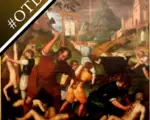
On this day in Tudor history, 3rd March 1528, Margaret Tudor, sister of King Henry VIII and widow of King James IV of Scotland, married for the third time.
Margaret, 38 years old, had already been twice married. Her first husband, King James IV of Scotland, had died at the Battle of Flodden in 1513, leaving her as regent for their young son, James V. However, her controversial second marriage to Archibald Douglas, 6th Earl of Angus, led to political turmoil. The Scottish nobility opposed the match, and she lost her position as regent. When she returned to Scotland after a brief stay in England, she discovered that Angus had been living openly with a former lover, Lady Jane Stewart. Determined not to remain in an unhappy marriage, Margaret fought for an annulment, despite opposition from none other than her own brother, Henry VIII, who at the time did not believe in divorce.
[Read More...]













